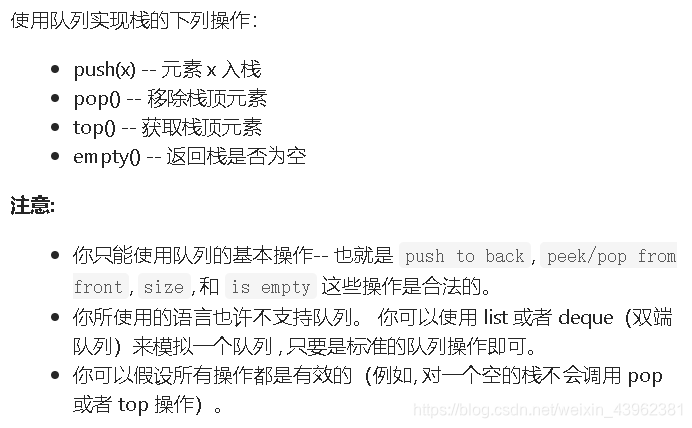Requisitos de la asignatura:

Usa la cola para lograr la pila
El principio de dejar el equipo: primero en entrar, primero en salir. El principio de apilamiento: último en entrar, primero en salir.
Por ejemplo:
hay cuatro elementos 1, 2, 3 y 4 en el equipo a su vez, el orden de su salida de la cola es: 1, 2, 3, 4.
Si se introducen 1, 2, 3, 4 en la pila a su vez, el orden de salida es 4, 3, 2, 1.
Es decir, lo que elimina la operación pop es el último elemento 4 de la cola actual. Luego solo necesitamos sacar los primeros 3 elementos y volver a ingresar a la cola. En este momento, 4 es el elemento líder del equipo, y luego sacarlo de la cola. Mire el diagrama a continuación:

Las operaciones restantes, como obtener el elemento superior de la pila, destruir la pila, etc., son relativamente simples, por lo que no entraré en detalles aquí y adjuntaré el enlace para realizar la pila con la cola: enlace de código de código.
Y el código completo:
#define _CRT_SECURE_NO_WARNINGS 1
#include<stdio.h>
#include<stdlib.h>
typedef int Qdatatype;
typedef struct Qnode {
Qdatatype data;
struct Qnode* next;
}Qnode;
typedef struct Queue {
//头尾指针
struct Qnode*head;
struct Qnode*tail;
}Queue;
//初始化
void Init(Queue* q)
{
if (q == NULL)
return;
q->head = q->tail = NULL;
}
//创建新结点
struct Qnode* creatnode(Qdatatype val)
{
struct Qnode* node = (struct Qnode*)malloc(sizeof(struct Qnode));
node->data = val;
node->next = NULL;
return node;
}
//入队-尾插
void Queuepush(Queue* q,Qdatatype val)
{
if (q == NULL)
return;
// 尾插
struct Qnode*node = creatnode(val);
if (q->head == NULL)
q->head = q->tail = node;
else
{
q->tail->next = node;
q->tail = node;
}
}
//出队-头删
void Queuepop(Queue* q)
{
if (q == NULL||q->head==NULL)
return;
//头删
struct Qnode* next = q->head->next;
free(q->head);
q->head = next;
//若该队列只有一个结点,尾指针需要置空
if (q->head == NULL)
q->tail = NULL;
}
//获取队首元素
Qdatatype Queuefront(Queue* q)
{
return q->head->data;
}
//队尾元素
Qdatatype Queueback(Queue* q)
{
return q->tail->data;
}
//判断队列是否为空
int Queueempty(Queue* q)
{
if (q->head == NULL)
return 1;
else
return 0;
}
//队列大小
int Queuesize(Queue* q)
{
int n = 0;
struct Qnode*p=q->head;
while (p)
{
++n;
p = p->next;
}
return n;
}
//销毁队列
void Queuedestory(Queue*q)
{
struct Qnode*cur=q->head;
while (cur)
{
struct Qnode*next = cur->next;
free(cur);
cur = next;
}
q->head = q->tail = NULL;
}
typedef struct {
struct Queue q;
} MyStack;
/** Initialize your data structure here. */
MyStack* myStackCreate() {
MyStack* pst=(MyStack*)malloc(sizeof(MyStack));
Init(&pst->q);
return pst;
}
/** Push element x onto stack. */
void myStackPush(MyStack* obj, int x) {
Queuepush(&obj->q,x);
}
/** Removes the element on top of the stack and returns that element. */
int myStackPop(MyStack* obj) {
int n=Queuesize(&obj->q);
while(n>1)
{
//前n-1个元素出队再入队,此时队首为原来的队尾元素
int front=Queuefront(&obj->q);
Queuepop(&obj->q);
Queuepush(&obj->q,front);
--n;
}
int top=Queuefront(&obj->q);
Queuepop(&obj->q);
return top;
}
/** Get the top element. */
int myStackTop(MyStack* obj) {
return Queueback(&obj->q);
}
/** Returns whether the stack is empty. */
bool myStackEmpty(MyStack* obj) {
return Queueempty(&obj->q);
}
void myStackFree(MyStack* obj) {
Queuedestory(&obj->q);
free(obj);
}
/**
* Your MyStack struct will be instantiated and called as such:
* MyStack* obj = myStackCreate();
* myStackPush(obj, x);
* int param_2 = myStackPop(obj);
* int param_3 = myStackTop(obj);
* bool param_4 = myStackEmpty(obj);
* myStackFree(obj);
*/